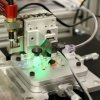.jpg)
DNA is a difficult molecule to work with, being very long and twisted into complex shapes. Studying entire DNA molecules is nearly impossible, as processes that manipulate it in order to make it manageable to analyze inevitably break the molecule into many pieces. Now researchers from McGill University are reporting in the Proceedings of the National Academy of Sciences on a new technique that loads long strains of DNA into a nanoscale imaging chamber where they can be studied whole. The hope is that the technique will not only help researchers develop faster laboratory techniques, but that in clinical practice cancer and other diseases can be diagnosed significantly faster.
The technique, called Convex Lens-Induced Confinement (CLIC), loads the DNA samples into the chamber from above as opposed to being injected forcefully using pressure. This maintains the structure of the molecule and doesn’t require complex reconstruction of the genome following analysis of individual samples.
“It’s like squeezing many soft spaghetti noodles into long narrow tubes without breaking them,” said Prof. Sabrina Leslie of McGill. “Once these long strands of DNA are gently squeezed down into nanochannels from a nanoscale bath above, they become effectively rigid which means that we can map positions along uniformly stretched strands of DNA, while holding them still. This means diagnostics can be performed quickly, one cell at a time, which is critical for diagnosing many pre-natal conditions and the onset of cancer.”
“Current practices of genomic analysis typically require tens of thousands of cells worth of genomic material to obtain the information we need, but this new approach works with single cells,” says Dr. Rob Sladek of the Génome Québec Innovation Centre. “CLIC will allow researchers to avoid having to spend time stitching together maps of entire genomes as we do under current techniques, and promises to make genomic analysis a much simpler and more efficient process.”
source:McGill University

